







Back to Observing Reports
I've decided to list some of the highlights during our observing with the 48". Jimi and I are hard core dim galaxy hounds...so we focused on objects at the edge of averted vision with some interesting looking galaxies.
So here it is...
Observed with Jimi Lowrey and Faith Jordan.
 NGC
3242 (10 24 46.2 -18
38
34 75” 8.6p *13.3) Okay, we started off with some
serious eye
candy.
NGC
3242 (10 24 46.2 -18
38
34 75” 8.6p *13.3) Okay, we started off with some
serious eye
candy.
48” (488x and 813x) – 3D appearance. Two bright lobes. Star appears behind the nebula. A distinct pink hue to the outer ring and yellowish on the inner ring.
Image taken by Hubble Space Telescope
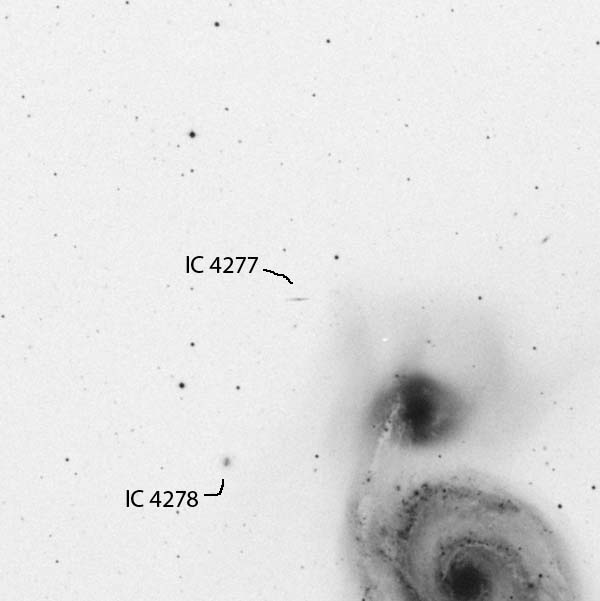 M-51 area
(two small IC galaxies just off the companion of M-51)
M-51 area
(two small IC galaxies just off the companion of M-51)
48” (488x)
IC 4277 (13 30 17 +47 18 50 0.7 x 0.2’ -) – considerably faint, thin spindle with a slightly brighter center. PA = 90
IC 4278 (13 30 27.5 +47 14 48
0.5x 0.4’ - ) – considerably
bright, round glow with diffuse edges
and a slightly
brighter center.
Note: This should be observable
objects
with a 25" or larger telescope.
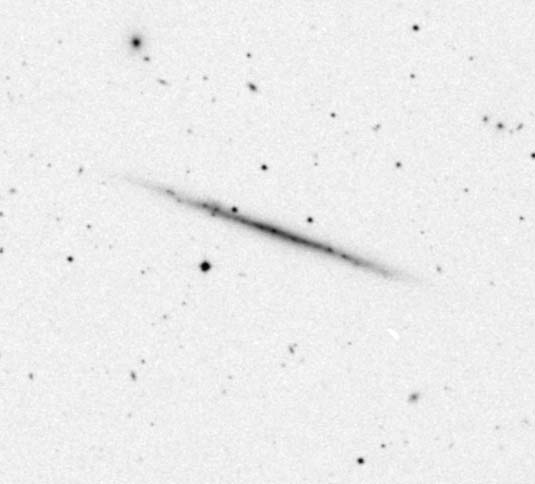 UGC 9242 (14 25 20.9 +39
32 22 5.0 x 0.4’ 14.1b)
UGC 9242 (14 25 20.9 +39
32 22 5.0 x 0.4’ 14.1b)
48” (488 and 813x) – very thin streak with two major knots. 3.8’ long and PA = 60 One knot is 1.0’ NE of center. A 17th mag star lies just west of the knot. The other knot is 1.4 SW. Bright center.
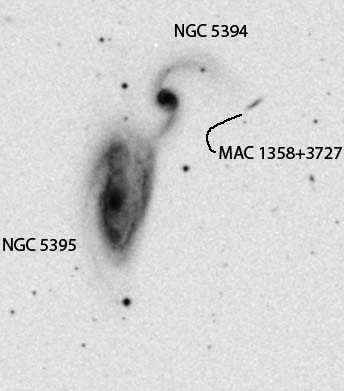 NGC 5395 - Arp 84 (13 58
37.6 +37 25 31 3.1
x
1.6’ 12.1b)
NGC 5395 - Arp 84 (13 58
37.6 +37 25 31 3.1
x
1.6’ 12.1b)
48” (488 and 813x) – The nucleus was bright and 2:1 elongated. The east arm was fairly weak and ¼ the length of the west arm. The west arm was dominate and attached to the loose spiral arms of NGC 5394. Both spiral arms of NGC 5394 were traced and symmetrical to each other.
MAC 1358+3727 is a considerably faint glow 1.5’ west of NGC 5394.
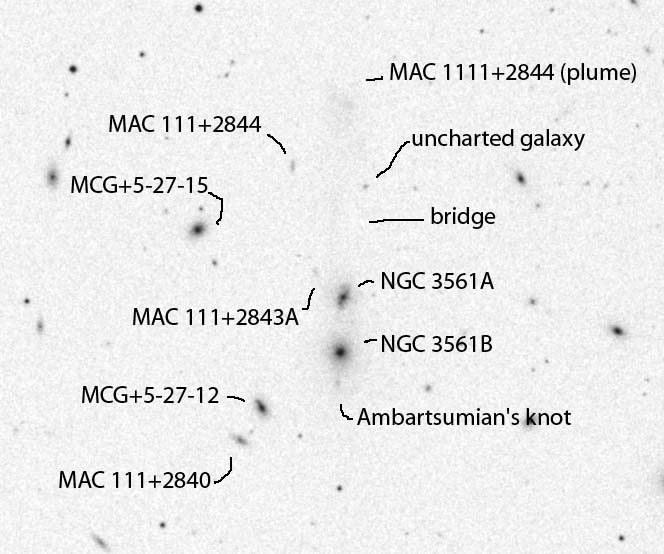 Arp 105 – NGC 3561B
and 3561A (11 11 13.3
+28 41 46 0.7 x 0.7’ 14.7)
Arp 105 – NGC 3561B
and 3561A (11 11 13.3
+28 41 46 0.7 x 0.7’ 14.7)
(AINTNO #22 object) - here is
some really dim stuff - features that we observed.
48” (488 and 813x) - Ambartsumian's knot was detected as a “stellaring” within a very small glow just off the southern edge of NGC 3561B. The plume (labeled as MAC 1111+2845A) north of NGC 3561A was detected fairly easily about 3’ north. It appeared as an irregular knotted glow with a very faint, but obvious bridge connecting it to the north edge of NGC 3561A. MAC 1111+2843A, a knot just off the NE edge of NGC 3561A was a very faint 2:1 elongated glow pointed away from the center. MCG+5-27-12 was a considerably bright 3:2 elongated glow located 1.5’ SE of NGC 3561B. MAC 1111+2840 was a faint 2:1 elongated patch located 45” SE of MCG+5-27-12. MCG+5-27-15 (located 2.8’ NE of NGC 3561A) was a bright round glow with defined edges. MAC 1111+2844 was an extremely faint round glow and lies just east of the bridge. Another extremely faint glow (unlabeled galaxy) was detected on the other side of the bridge.
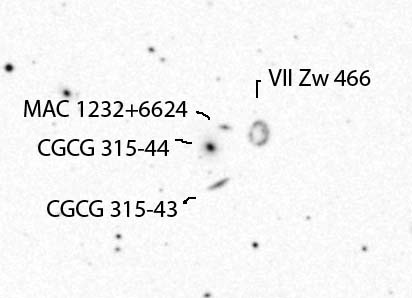 VII Zw 466 (12
32 05.2 +66
24 10 0.5’ 15.8)
VII Zw 466 (12
32 05.2 +66
24 10 0.5’ 15.8)
48” (813x) – The ring was uneven. The west side was brighter and knotty. The east side was slightly dimmer with two “missing” parts. Actually the missing parts are much dimmer than the rest of the ring. Three other galaxies to the east of the ring were easily detected. CGCG 315-44, the middle one was the brightest of the three, followed by CGCG 315-43. MAC 1232+6624 was the dimmest and smallest.
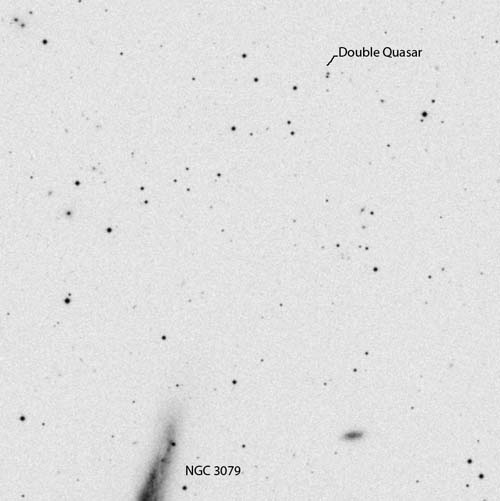 Double Quasar (10 01 21 +55 53
50 16.5 separation:
6.1”)
Double Quasar (10 01 21 +55 53
50 16.5 separation:
6.1”)
48” (488x) – Two well separated stellar objects and distinctly blue. I did not detect the lensing galaxy, but Faith did.
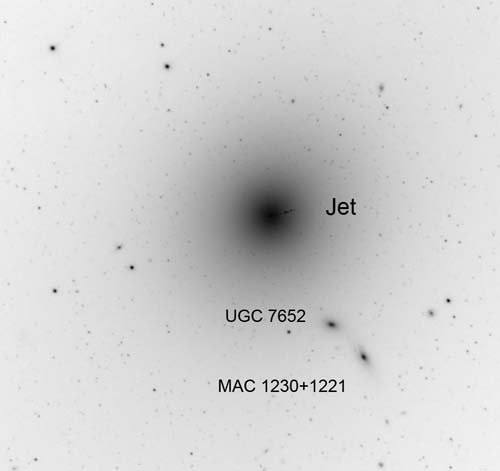 M-87 jet
(12 30 49.7 +12 23 24)
M-87 jet
(12 30 49.7 +12 23 24)
48” (488 and 813x) - Jet was detected as a faint ray sticking just out of the core. PA = 300. Two fairly faint galaxies were easily detected at PA = 220.
Cropped from original photo taken by Adam Block/Mt. Lemmon Sky Center/U. Arizona
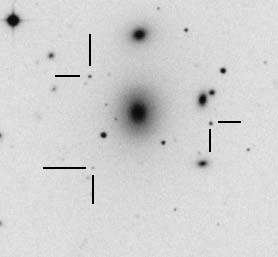 Lensed quasars around
NGC 3842 (Q 1141+202)
(AINTNO #66
object)
Lensed quasars around
NGC 3842 (Q 1141+202)
(AINTNO #66
object)
#1 11 44 06.0 +19 57 37 mag 18.5
#2 11 43 57.4 +19 56 53 mag 18.5
#3 11 44 05.3 +19 56 03 mag 21.0
48” (488 and 813x) - The two bright ones were easily detected, one to the NE (1.2’ from core of NGC 3842) and W (1.2’) from NGC 3842. The dimmest one needed some time before it popped in and out when the seeing steadied. Located 1.2’ SE of NGC 3842.
There were numerous galaxies around NGC 3842, I didn’t take note the details of the nearby galaxies I saw, but CGCG 97-90, MAC 1143+1957, PGC 36468, NGC 3841, NGC 3845, NGC 3837, UGC 6697 and MAC 1143+1958 were among them. I was focusing on the quasars.
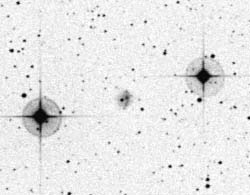 DHW 1-2 (17 06 55.0 -09
46 58.9 30x20” -
)
DHW 1-2 (17 06 55.0 -09
46 58.9 30x20” -
)
48” (488x) –Faint 3:1 elongated glow. A brighter knot visible at the center. PA = 0 and 30” long. Responds well to UHC filter. No central star with 10 TMB Supermonocentric, but detected with 10 ZAO-II. The star lies just east of the center of the glow. The PNe sits equidistant between a pair of 9.3 magnitude stars to the east and west.
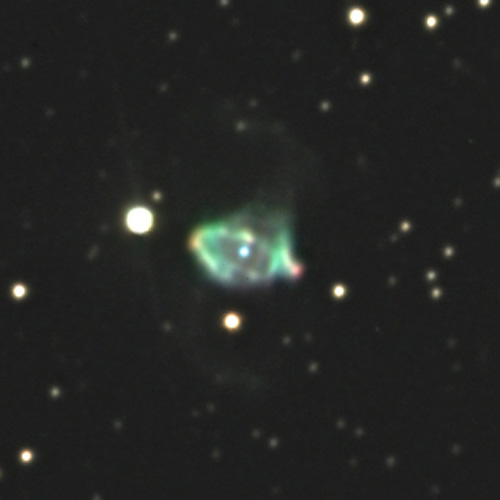 NGC 6309 (17 14 04.5 -12 4
41 16” 10.8p)
NGC 6309 (17 14 04.5 -12 4
41 16” 10.8p)
48” (488x) –
Very
bright and pale blue. Two bright parts aligned NNW and SSE. The northern and brighter part is elongated,
rectangular and about 15” long. The smaller part is roughly round and
about 5”
in diameter. Very faint filaments were
detected
mainly to the west and east sides. A
12.6 magnitude star lies 12” off the north edge. Forgot
to
look
for the central star.
Adam
Block/NOAO/AURA/NSF
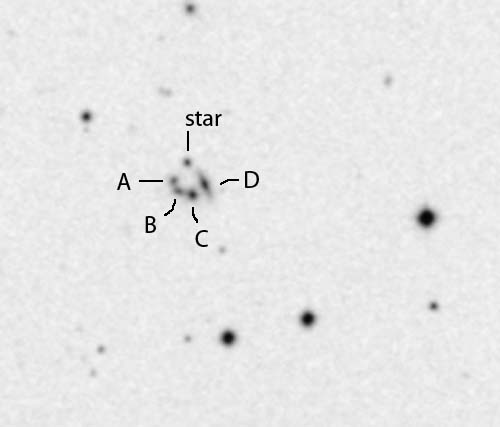 Rose 13 (13 28 26.7 +15
50 29.6)
Rose 13 (13 28 26.7 +15
50 29.6)
48” (813x) - Only three galaxies were resolved with a star on the north. One of the three was distinctly edge on. Component “B” not detected.
 "Double Double Quasar" (09 03
50 +35 11 22) - The main pair is about 16" apart and is mag 14.4
and 14.2. The smaller "stars" to the east are mag 18 and
19. Separation is about 5".
"Double Double Quasar" (09 03
50 +35 11 22) - The main pair is about 16" apart and is mag 14.4
and 14.2. The smaller "stars" to the east are mag 18 and
19. Separation is about 5".
The two bright stars are very easily separated. When the seeing steadied enough, the two dimmer members popped in and out, otherwise it showed an elongation off the brighter members. The northern pair is a bit dimmer than the southern pair.
Back to Observing Reports
All Observing Reports are copyrighted by Alvin Huey. You can print them for personal use only.
Components Aids Guides Observing Guides Reports
